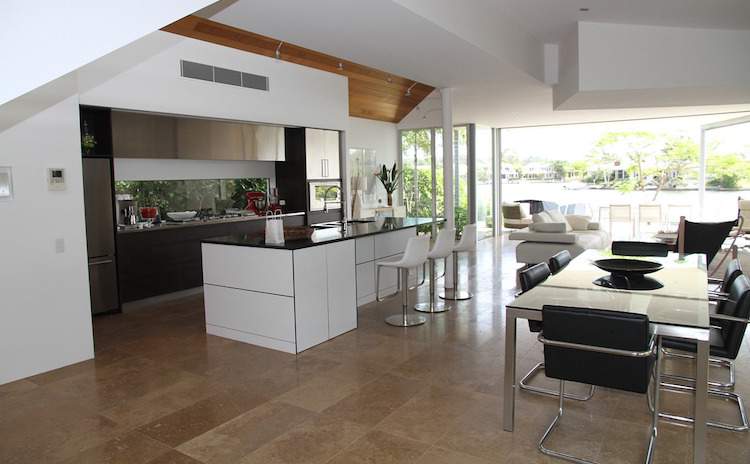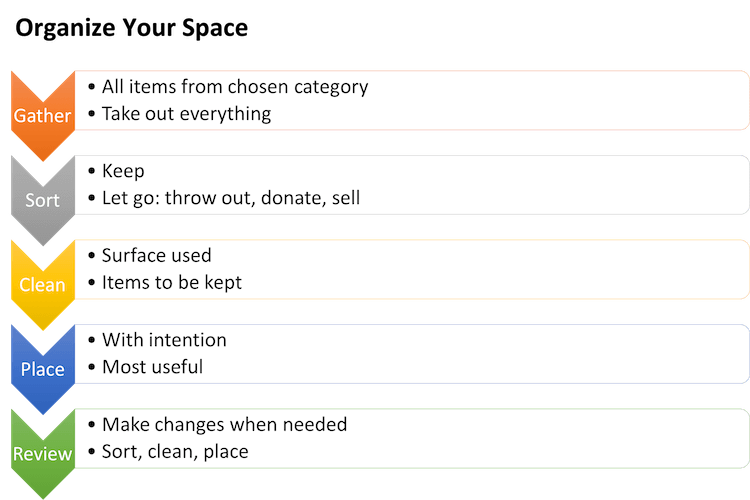How to Organize Your Space and Keep It Neat

Last week I spent three full days organizing the kitchen. It’s not that I had a lot of stuff. For years I’ve been eliminating more than adding to the kitchen. On the outside, it looked neat. Everything was out of sight. The kitchen cabinets though told a different story.
Behind closed cabinet doors was a big mess. The extra space was used haphazardly. The only items that were stored relatively well were the things we used on a daily basis. The rest was hidden chaos.
I honestly considered the kitchen cabinets a disgrace. And it wasn’t about anyone else but myself. It bothered me in every possible way. The display didn’t look good. The space was wasted and not optimized, and things were not logically and practically stored.
How can someone simplify and add to the chaos?
The answer is quite simple. There was no organizational plan or follow up.
Once we trim the excess, we need to look at the space and items we have and organize things in the most helpful way.
And this is the focus of this article—to get us to organize a space and then to keep it that way.
Where to start?
We can’t handle everything at the same time. So we need to work with one specific area.
Pick a life area.
The main thing is to work with one area, or category. You can start with the one that gives you the most pain. The common categories are:
- Clothing
- Books
- Paperwork and files
- Photos
- Trinkets and things on display
- Kitchenware
- Electronics and gadgets
- Bedding and towels
- Other: jewelry and accessories, makeup, tools
Any area in your space that feels chaotic can benefit from organizing.
Once you’ve chosen an area, start the organizing process.
The organizing process
Gather all the items in one place.
For example, if you have books all over your house, get them all in one place. The most logical place is the one where most items are stored. So if you have a bookcase, get all the books in other areas and place them next to the bookcase.
In my example I had all the kitchen stuff in the kitchen.
Take everything out.
Empty the shelves, closets, boxes, or any other space used to store your items. You can place the items on the floor, or on a table (that’s what I did in the kitchen).
Sort the items.
This is the decluttering/eliminating phase. Get rid of anything that hasn’t been used, or you don’t think you’re going to use.
Go nuts.
Be as ruthless as you can. If something hasn’t been used for years, what are the chances you’re going to use it now?
Keep only what you actually use. These are the things that are going to stay. The rest will go.
For the items you let go of, decide how you’re going to dispose of them: throw out, donate, or sell.
Put these items in the trash, or in boxes and mark them as ready to go. If you’re planning on selling something, take the time to do it now. Otherwise, it’s going to sit for a very long time before you get around to it.
Clean.
Clean the empty space. Vacuum the floors, wipe shelves down, and fix anything that needs repair.
Clean your items by wiping them one at a time.
Place your items with intention.
This is the most important thing in organizing your space. Your items need to be put in a way that’s most useful to you.
They need to be fairly visible, can be picked up quickly, and can easily be put back in the same spot after use.
Leave some space to give the items (and your eyes) room to breathe. It’s not only more aesthetically pleasing, but it also makes it easy to take things out and put them back in their place.
Use your space and review.
After putting everything in its place, work with the area for a while. Keep what works and change what doesn’t.
Every few months, take a look and see if anything is out of place, or is not being used.
You can repeat the same process as needed: sort your items and let go of more stuff, clean the surfaces, and then place items with purpose.
The process is fairly simple. But it takes time and effort. A few things to consider below.
Practical considerations
Initial organizing will take longer than you think. If you have a lot of stuff, it will take much longer than you anticipate to get it done properly. I thought the kitchen would take me a day. It took me three days. And that was with most stuff eliminated.
Don’t stop till you’re done. Stopping before you’re done will not give you the satisfaction of completion. You’ll also lose momentum and you’ll need to go back a few steps to determine where you stopped.
If you have to stop, keep a detailed list of what needs to be done. This way you don’t have to waste time going over what you did before.
Digitize when needed. If you need to keep a record of an item, take a picture and add it to your journal or a folder that you can look at and reflect on instead of the item itself.
Focus on the use value of an item. Before deciding to donate something, think if it’s going to be useful or not. Donate only the things that others will use. You don’t want to dump your clutter on someone else. If it’s a useless or broken gadget, throw it out.
Keep a donate box handy, and use it whenever you buy something. Once you replace something, let go of the old item. Keep a donate box that you can take to charity on a regular basis and add items to it. This way you don’t have to keep things in your space that you have no use for.
Practice makes improvement. The more you organize and let go of stuff, the easier it gets. I haven’t organized my kitchen cabinets in probably a couple of years. If I do it every six months, it should not take more than a couple of hours.
Use the home staging technique. If you don’t know how you want your space to look, imagine what it’d look like if you wanted to stage your house before selling it. Or imagine what the space would look like if you wanted to buy it. This is just an exercise to get you to see your physical space in the best light—based on your personal preferences and taste.
It’s an ongoing process. Organizing once works for a short while only. We need to be mindful of changes and make sure we put things in their place. If we turn tidying up into a daily habit, we’ll spend less time doing the seasonal clean up and review.
Unchecked empty space is a hotbed of chaos. It’s fairly easy to put things away in haste when you have room. So it’s more important to check your empty space and make sure you don’t have useless things stored, just because you have space.
Organizing may not be a favorite past time. But it’s worth the effort. An organized space will give us a sense of peace and expansion. It will also serve its intended purpose of housing our belongings in an efficient and pleasing way.
I hope you found the article useful. Below is a diagram that illustrates the main points for easy reference. Click here for a larger image.
